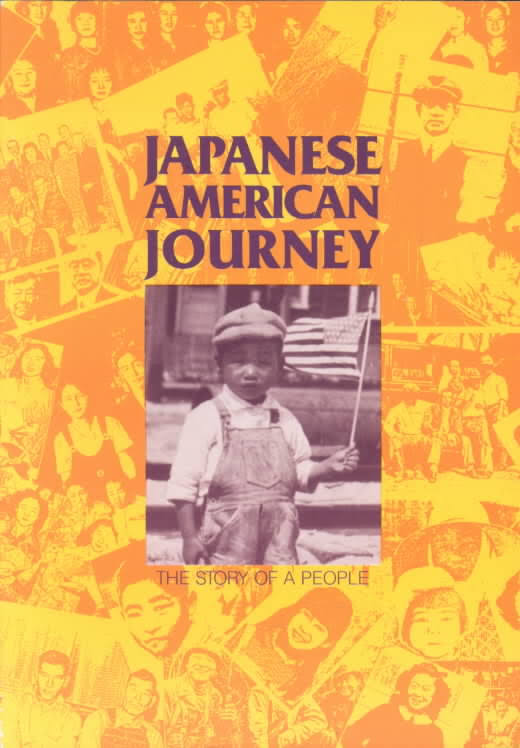Japanese American Journey: The Story of a People (book)
Creators: Japanese American Curriculum Project
Overview work for children on the Japanese American experience produced by the Japanese American Curriculum Project (JACP) in 1985. Consisting of a historical overview, eleven biographies of notable Japanese Americans, and three short stories, Japanese American Journey was adapted from a 1970 JACP publication titled Japanese Americans: The Untold Story .
Intended for students in grades 5 to 8, Japanese American Journey was authored by a group of San Francisco Bay Area writers and educators that included Takako Endo, Florence M. Hongo, Sadao Kinoshita, Katherine Reyes, Donald Y. Sekimura, Rosie Shimonishi, and Shizue Yoshina. The historical overview sections includes six chapters and starts with the World War II incarceration and Nisei military service, before going back to cover immigration, the anti-Japanese movement, the prewar community, and the postwar years. Eleven short biographies follow, on Joseph Heco, Kanaye Nagasawa, Kyutaro Abiko , George Shima, Keisaburo Koda, Kiyoshi Hirasaki , Yoshimi Shibata, Mike Masaoka , Daniel K. Inouye , Yoshiko Uchida , and Edison Uno . A final section includes the short stories "Uncle Kanda's Black Cat" by Yoshiko Uchida, "One Happy Family" by Toshio Mori , and "Gambatte" by Valerie Pang. A glossary, references and author profiles follow. The historical overview section runs 67 pages, the biographies 80 pages, and the short stories 22 pages. The book is dedicated to activist Edison Uno, one of the authors of The Untold Story .
Japanese American Journey derived from an earlier JACP work titled Japanese Americans: The Untold Story , published in 1971 by Holt, Rinehard and Winston. Inspired by the lack of curricular materials that presented Japanese Americans in a non-stereotypical fashion, JACP set out to correct "existing omissions and gross distortions in the story of Japanese Americans in present curriculum materials" in its own publications. However The Untold Story received an unexpectedly rocky reception from Japanese Americans when published. In particular, the Buddhist Churches of America (BCA) called the book "racist" and "anti-Buddhist," calling it "a gross misrepresentation of the true picture of the lives of Japanese Americans." Among other things, the BCA pointed out that all seven of the biographies featured in the book were of Christian men. The book also received criticism for derogatory statements about Chinese Americans. Eventually, the State of California Curriculum Commission rejected the book, and the Japanese American Citizens League also went on record opposing the book. [1]
In response, Japanese American Journey featured a rewritten historical overview and a somewhat more diverse selection of biographies (though only one of the eleven is a woman). Reviewing it for the Pacific Citizen , June Kizu called it "an informative, sensitive and relevant book" that was "written in a clear, straightforward style." However Raymond Okamura, while acknowledging that the claim of religious and ethnic bias had been addressed, criticized the book for its "model minority" framework and use of euphemistic language. [2]
Relative to other overview works, Japanese American Journey presents a largely accurate history. Among the minor errors: calling Secretary of War Henry L. Stimson the "Secretary of Defense" (page 7) and calling Hawai'i "not a state but a territory of the United States" at the time Japanese immigration began (22; it was at that time an independent monarchy). In describing the concentration camp experience it makes some over general statements, that barracks had "only a coal stove for heat" (10; depending on the camp, some were heated by oil or wood) and that ""Twelve barracks ... made up a block" (12; the number of barracks in a block varied from camp to camp).
Footnotes
- ↑ Japanese American Curriculum Project, Japanese Americans: The Untold Story (New York: Holt, Rinehart and Winston, 1971), iv; Harry Honda, "Nisei Authored Textbook Called 'Racist, anti-Buddhist' by BCA," Pacific Citizen , Oct. 23, 1970, 1 Pacific Citizen , Nov. 13, 1970, 1, 3.
- ↑ June Kizu, "A 'Journey' Worth Taking," Pacific Citizen , Feb. 7, 1986, 8; Raymond Okamura, "'JA Journey' a Bad Trip," Pacific Citizen , Mar. 14, 1986, 5.
Find in the Digital Library of Japanese American Incarceration
Japanese American Journey: The Story of a People
This item has been made freely available in the Digital Library of Japanese American Incarceration , a collaborative project with Internet Archive .
Might also like
The Invisible Thread
by Yoshiko Uchida;
Weedflower
by Cynthia Kadohata;
Journey to Topaz
by Yoshiko Uchida
| Author | Japanese American Curriculum Project |
|---|---|
| Pages | 180 |
| Publication Date | 1985 |
